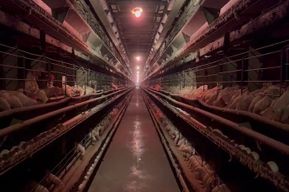
We have 30 days to take on Goliath – again
November 12, 2025
February 18, 2022
Norway banned fur farming in 2019 (it comes into force in 2025) and a huge part of the campaign against fur farming was publicizing images from fur farms. We encourage you to read Jeanett's story from our team in Norway.

In the winter of 2020, I started to work on my thesis in the Master's degree programme; Peace and Conflict Transformation, at The Arctic University of Norway. My thesis aimed at exploring the case of how animal protection activists exposed the fur industry in Norway through imagery. I wanted to gain an in-depth understanding of why and how activists implemented the strategy of imagery to expose the fur industry in Norway. And to understand what effects these images had on Norwegian society, I conducted interviews and literature reviews of reports and analyzed the media in the relevant time period.
The activists' images changed the agenda
In the years 2008–2012, parts of the animal protection movement adopted new strategies to gain attention to the Norwegian fur industry and the suffering the fur animals endure. Activists from the animal protection organisation, Dyrebeskyttelsen Norge and Nettverk for dyrs frihet, systematically inspected over 200 fur farms across the country and documented the conditions in the industry with images and film footage. See their findings here. Their goal was to expose the industry and to get their cause on the public and political agenda, with the end goal to attain a ban on the whole industry.
Every year, the activists documented and exposed extensive violations of the animal welfare act on the farms. Never before had so much documentation been obtained about conditions in the fur industry or any other husbandry industry in Norway. The images were then featured in various news broadcasts, documentaries, and debate programs and in a number of other media contexts, and the activists achieved their goal of getting fur farming on the public and political agenda.

The activists' images significantly changed public and political attitudes toward fur
I found a marked difference in citizens’ attitudes toward fur farms after the activist images were released to the media. Before the activists started their documentation work in 2008, there had been little exposure of Norwegian fur farms, and the subject was rarely part of the public and political debate or in the media. But this changed after the activists' imagery went public. The images spurred a political debate and public outrage, where the political debate concentrated around whether or not to dismantle the industry and the public demanding the industry to be dismantled.
During the year the activists' images were disseminated by the media, politicians across the political spectrum reacted directly and strongly to the images depicting injured and suffering fur animals, resulting in political parties changing their policies and professional bodies demanding that the industry be dismantled.
The activists' images also significantly changed public attitudes toward fur as the findings in my study demonstrate. The public’s engagement became stronger, and eventually, the majority of the Norwegian public favoured a ban. The increased engagement is shown through opinion polls, record attendance in mass mobilization events against the industry, and an increase in readers’ letters regarding the fur industry.

Fur farming is finally banned in Norway
In June 2019, Norway banned fur farming, and the ban will enter into force in February 2025. Was this victory due to the activist images? It is hard to assess a specific outcome of images because social and political impacts and changes occur gradually. Images can spur outrage and political debate, but changing policy often takes time. Other factors have also been important for achieving a ban in Norway. However, the findings in my study demonstrate that the political debate and the strong public opinion favouring a ban were direct effects of the images. It is evident in this study that public and political debate and engagement with the issue of the treatment of fur animals were not as prevalent before the images.
Never doubt that a small group of thoughtful, committed citizens can change the world; indeed, it's the only thing that ever has.
Margaret Mead

Link to Master’s thesis: How does imagery matter for activists dissemination of their ideas and political mobilization? A case study of the exposure of the fur industry in Norway.